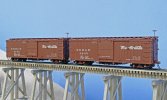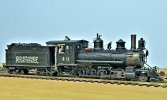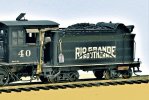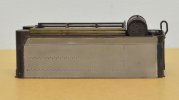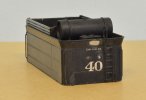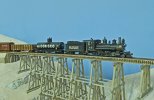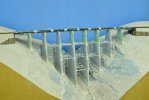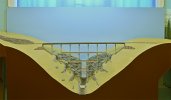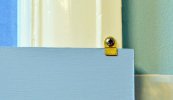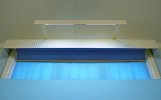You are using an out of date browser. It may not display this or other websites correctly.
You should upgrade or use an alternative browser.
You should upgrade or use an alternative browser.
The D&RGW and Rio Grande Southern in 0n3
- Thread starter PhilH
- Start date
-
- Tags
- d&rgw narrow gauge
PhilH
Western Thunderer
So what do you do when you've got several unfinished jobs on the go and can't decide which one to do next - start another ! Actually this one had already been started by someone else so getting it finished didn't take too much effort.
I was given two part completed D&RGW 0n3 box cars by a friend who had acquired them in the same condition, presumably originally constructed from kits. The bodies are built of wood with moulded plastic doors and brass detail castings. As received they were more or less complete apart from paint and lettering, but I added the end supports to the roof walks, a couple of missing door stops, couplers, air hoses and most of the grab irons needed straightening or refixing. The trucks are cast brass and were provided with sprung pivots, as I don't like wobbly freight cars ! Painting was first with Tamiya red oxide primer; then a mix of Tamiya acrylic browns and red to represent D&RGW boxcar red (slightly redder than the usual boxcar red); Vallejo gloss varnish (before decals) and Vallejo satin varnish (after decals). I found the result a little too shiny so finished off with several coats of Dullcote. The decals are by Thinfilm and there's quite a lot of lettering on these cars, including the numbers applied individually there are 40 separate decals on each car.
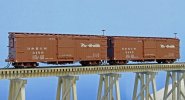
PhilH
Western Thunderer
I bought this Mountain Model Imports Rio Grande Southern #40 from a friend already equipped for DCC sound and reasonably well weathered. One problem was the tender had different 'Sunrise' decals on each side and one wasn't properly fixed and had started flaking off. Other problems with the tender were it had a backup light which the prototype didn't have and the pipework from the air tank was incorrect.
Most of the loose decal came off quite easily but efforts to remove it all revealed the earlier livery underneath with a large number '40', so I decided to strip both of the tender sides completely down to the bare metal diecasting. Various 'chemicals' were used plus scraping, but removing all the old paint around all the rivets proved difficult, so I masked any areas I didn't want the paint removed and stripped the remaining paint off by grit blasting.
The tender rear with the backup light removed, the ladder was later removed to the centre. The only photo I could find showing the rear of the tender indicated that instead of the usual large loco number in the centre there were two smaller numbers low down on each rear corner.
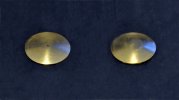
Two new domed ends were turned for the tender air cylinder with the pipework connected to the centre.
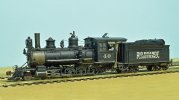
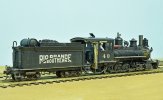
The tender sides and ends were repainted with Tamiya grey primer and semi gloss black, then Thinfilm decals applied and varnished with Vallejo satin varnish. This was a little bit shinier than I liked so it was given a light coat of Dullcote.
The only work required to the loco itself was the slight adjustment of the back to back on two sets of drivers and a spring under the pony truck pivot to prevent its habit of occasionally jumping off the track. A seated fireman was added to the cab to replace the previous standing one balanced on the front of the tender.
The tender still requires the addition of the air retainer pipework at the front of the right hand side and I have a suitable brass casting, I think - somewhere ?, which requires fixing - if I can find it.
PhilH
Western Thunderer
Back to the trestle
It seemed a good idea (before I started !) to cover the woodwork before painting the plaster. Maybe a bit of cling film would do the job, but no it didn't and it turned into a major operation with paper, masking tape, cooking foil and cling film.
The result so far - I was aiming for a light brownish grey for the rock and I've fiddled about with it for days, washes, sprays, dry brushing, lighter, darker, highlighting the top edges in white, etc, etc, and I still think it needs a bit more brown.
The ground cover will be a sandy brown colour representing dirt and scree and when that's in place I might have another fiddle with the colour of the rock. Grass will be minimal, just a few clumps here and there, with bushes and spruce trees, the latter mainly at the rear behind the track.
I decided that a photo printed window blind wouldn't work so I've added a hardboard backscene on which I'll paint the scenery, or should I say have a go at painting the scenery.
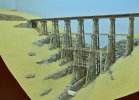
I need some small pebbles to go in and around the river before I add the water.
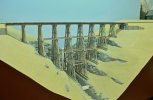
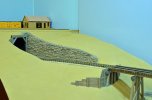
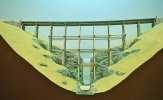
For a different view I must confess to sitting on the floor sometimes and watching the trains going round overhead.
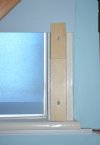
The backscene sits on two supports sitting on the window sill and fixed to the window frame at each end and there's also another support from the window sill in the centre.
and its fixed at the top with two small clips fixed to the window frame. By removing the clips the backscene can be lifted out clear of the window.
Additional lighting is by two 12v LED bar lights fixed to the window pelmet and this has effectively eliminated the shadow of the trestle on the backscene and put it more appropriately under the trestle.
It seemed a good idea (before I started !) to cover the woodwork before painting the plaster. Maybe a bit of cling film would do the job, but no it didn't and it turned into a major operation with paper, masking tape, cooking foil and cling film.
The result so far - I was aiming for a light brownish grey for the rock and I've fiddled about with it for days, washes, sprays, dry brushing, lighter, darker, highlighting the top edges in white, etc, etc, and I still think it needs a bit more brown.
The ground cover will be a sandy brown colour representing dirt and scree and when that's in place I might have another fiddle with the colour of the rock. Grass will be minimal, just a few clumps here and there, with bushes and spruce trees, the latter mainly at the rear behind the track.
I decided that a photo printed window blind wouldn't work so I've added a hardboard backscene on which I'll paint the scenery, or should I say have a go at painting the scenery.

I need some small pebbles to go in and around the river before I add the water.



For a different view I must confess to sitting on the floor sometimes and watching the trains going round overhead.


The backscene sits on two supports sitting on the window sill and fixed to the window frame at each end and there's also another support from the window sill in the centre.
and its fixed at the top with two small clips fixed to the window frame. By removing the clips the backscene can be lifted out clear of the window.
Additional lighting is by two 12v LED bar lights fixed to the window pelmet and this has effectively eliminated the shadow of the trestle on the backscene and put it more appropriately under the trestle.

